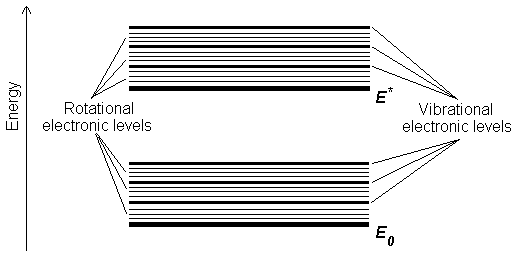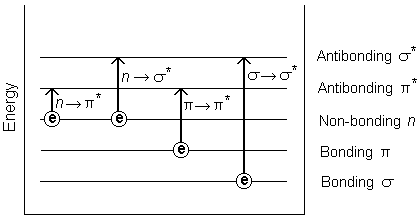

A = ebc, where e is a constant of proportionality, called the absorbtivity.
Different molecules absorb radiation of different wavelengths. An absorption spectrum will show a number of absorption bands corresponding to structural groups within the molecule. For example, the absorption that is observed in the UV region for the carbonyl group in acetone is of the same wavelength as the absorption from the carbonyl group in diethyl ketone.
For a comprehensive discussion of Beer's Law, click here
When an atom or molecule absorbs energy, electrons are promoted from their ground state to an excited state. In a molecule, the atoms can rotate and vibrate with respect to each other. These vibrations and rotations also have discrete energy levels, which can be considered as being packed on top of each electronic level.

Possible electronic transitions of p, s, and n electrons are;

An electron in a bonding s orbital is excited to the corresponding antibonding orbital. The energy required is large. For example, methane (which has only C-H bonds, and can only undergo s ® s* transitions) shows an absorbance maximum at 125 nm. Absorption maxima due to s ® s* transitions are not seen in typical UV-Vis. spectra (200 - 700 nm)
Saturated compounds containing atoms with lone pairs (non-bonding electrons) are capable of n ® s* transitions. These transitions usually need less energy than s ® s * transitions. They can be initiated by light whose wavelength is in the range 150 - 250 nm. The number of organic functional groups with n ® s* peaks in the UV region is small.
Most absorption spectroscopy of organic compounds is based on transitions of n or p electrons to the p* excited state. This is because the absorption peaks for these transitions fall in an experimentally convenient region of the spectrum (200 - 700 nm). These transitions need an unsaturated group in the molecule to provide the p electrons.
Molar absorbtivities from n ® p* transitions are relatively low, and range from 10 to100 L mol-1 cm-1 . p ® p* transitions normally give molar absorbtivities between 1000 and 10,000 L mol-1 cm-1 .
The solvent in which the absorbing species is dissolved also has an effect on the spectrum of the species. Peaks resulting from n ® p* transitions are shifted to shorter wavelengths (blue shift) with increasing solvent polarity. This arises from increased solvation of the lone pair, which lowers the energy of the n orbital. Often (but not always), the reverse (i.e. red shift) is seen for p ® p* transitions. This is caused by attractive polarisation forces between the solvent and the absorber, which lower the energy levels of both the excited and unexcited states. This effect is greater for the excited state, and so the energy difference between the excited and unexcited states is slightly reduced - resulting in a small red shift. This effect also influences n ® p* transitions but is overshadowed by the blue shift resulting from solvation of lone pairs.
Many inorganic species show charge-transfer absorption and are called charge-transfer complexes. For a complex to demonstrate charge-transfer behaviour, one of its components must have electron donating properties and another component must be able to accept electrons. Absorption of radiation then involves the transfer of an electron from the donor to an orbital associated with the acceptor.
Molar absorbtivities from charge-transfer absorption are large (greater that 10,000 L mol-1 cm-1).
You should now be aware of why molecules absorb radiation in the UV and visible light regions, and why absorption spectra look the way they do.
After a short quiz, we will be considering the practical aspects of UV - Vis. spectroscopy, and looking at the instrumentation needed to perform this technique.
|
|
|
 Biosciences Homepage
Biosciences Homepage
 |